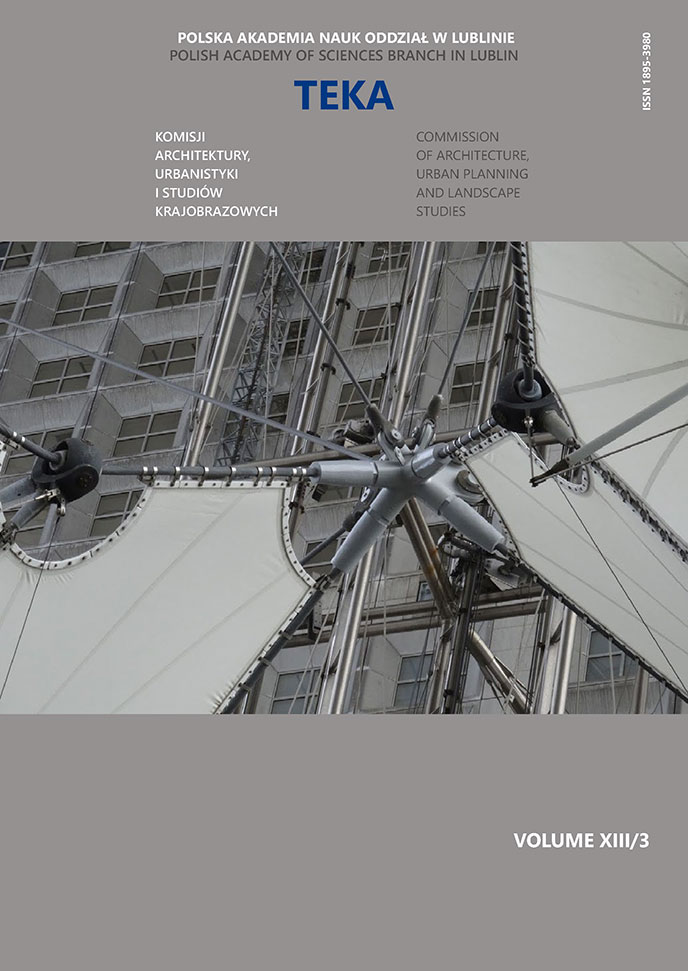Optimization of barrel vault surfaces using energetic potential method
Article Sidebar
Open full text
Issue Vol. 13 No. 3 (2017)
-
About historic stonework in Kraków
Anna Kulig7-13
-
Wstęp do metodologii oceny dotykowych modeli architektonicznych
Maciej Kłopotowski, Agnieszka Kłopotowska14-24
-
O mieszkalnictwie początku XXI wieku. Próba charakterystyki na podstawie europejskich realizacji
Maciej Kłopotowski25-42
-
Od rewaloryzacji idealnego miasta do ochrony historycznego krajobrazu Zamościa
Krzysztof Kazimierz Pawłowski43-52
-
Neolityczne megality Nałęczowa – debiut budownictwa na Lubelszczyźnie
Natalia Przesmycka, Lucjan Gazda53-59
-
Optimization of barrel vault surfaces using energetic potential method
Kajetan Sadowski60-66
-
“Straszny Dwór” (Haunted Manor) guesthouse in Tatarów in the Hutsul region and its designer Jerzy Romaszkan
Jacek Czubiński67-77
-
Participation of Stanisław Tomkowicz in the conservation of the Corpus Christi collegiate church in Biecz
Jacek Czubiński78-85
-
Shooting sport in the context of military objects in the middle war period of Poland
Wojciech Kocki, Elżbieta Przesmycka86-92
Archives
-
Vol. 15 No. 4
2019-12-30 6
-
Vol. 15 No. 3
2019-10-31 9
-
Vol. 15 No. 2
2019-06-28 12
-
Vol. 15 No. 1
2019-03-29 13
-
Vol. 14 No. 3
2018-10-28 14
-
Vol. 14 No. 2
2018-06-29 14
-
Vol. 14 No. 1
2018-03-30 13
-
Vol. 13 No. 4
2017-12-29 8
-
Vol. 13 No. 3
2017-09-29 9
-
Vol. 13 No. 2
2017-06-30 10
-
Vol. 13 No. 1
2017-03-31 10
-
Vol. 12 No. 4
2016-12-30 12
-
Vol. 12 No. 3
2016-09-30 10
-
Vol. 12 No. 2
2016-06-30 9
-
Vol. 12 No. 1
2016-03-31 8
-
Vol. 11 No. 4
2015-12-30 14
-
Vol. 11 No. 3
2015-09-30 7
-
Vol. 11 No. 2
2015-06-30 8
-
Vol. 11 No. 1
2015-03-31 11
Main Article Content
DOI
Authors
Abstract
The energy certification, introduced in 2009, enables interested parties or organizations to analyze the data developed during the preparation of energy performance certificates or the proposed energy performance of a building. Through comparatitive analysis, trends can be described using the criteria for shaping them as needed.
The author has made selected analyzes focusing on residential housing in the division of single family and multi-family housing. Obtained results indicate the existing and expected trends related to the reduction of fossil fuel consumption but also show their slow pace and in some cases even no change. The conclusions drawn show the reasons for a certain rate of change, enabling them to undertake actions supporting certain tendencies or initiating them.
As part of this work, the author analyzed selected indicators on the basis of their 168 energy certificates of residential buildings in 2014−2017.
Keywords:
References
Rozporządzeni Ministra Infrastruktury i Rozwoju w sprawie metodologii wyznaczania charakterystyki energetycznej budynku lub części budynku oraz świadectw charakterystyki energetycznej (Dz.U. poz. 376 z dn. 18 marca 2015 r.)
Ustawa o charakterystyce energetycznej budynków (Dz.U. poz. 1200 z 2014 r.)
Article Details
Abstract views: 234


